Alaska Economic Trends
Alaska Economic Trends is a monthly magazine that covers a range of economic topics.
Sign up for a free electronic subscription. 
Sign up for a paid print subscription.
Alaska Economic Trends are searchable from 1961 to the present using the Trends search page. The search can include any combination of the following: Key Words, Date Range, Author, Category
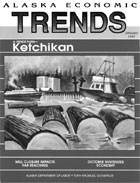
Ketchikan is a narrow. waterfront community that stretches about three miles along the shoreline of Revillagigedo Island at the southern end of the Southeast Alaska Panhandle. Perched between the waters of the Tongass Narrows and steep, forested mountain slopes, it is Alaska's southernmost major city and the state's fifth largest, with a population of about 8,700. The surrounding Ketchikan Gateway Borough is home to nearly 15,000 Alaskans.
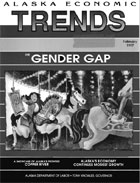
Although Alaska male workers, on average, continued to earn significantly more than female workers in 1995, the earnings gap between the two has narrowed significantly since 1990. Many factors can account for differences in average earnings between the genders, such as education, hours worked, or length on the job. But female workers earn less than male workers in virtually all age, industry and occupation categories, including typically female-dominated occupations.
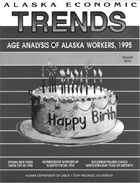
Age plays a large role in determining employment and compensation outcomes in economies everywhere, and Alaska is no exception. Circumstances related to life- cycle transitions are important to people's choices of whether to work or not to work, whether to work full-time or part-time, or whether to work seasonally or year-round. Compensation in the form of wages and salaries is also strongly influenced by age, differences in education levels, work experi- ence, child-rearing responsibilities, retire- ment, and other life-cycle factors.
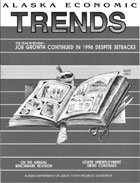
Despite setbacks, Alaska's economy grew for the ninth straight year in 1996, propelled by an expanding services sector, another solid visitor season, selected retall trade growth and a budding hard rock mining industry. However, job growth was slower than at any other time during the 1990s. Fishing and timber industry woes combined with federal government downsizing, a slower construction season, and continued consolidation in Alaska's oil industry to further slow employment growth. Nevertheless, wage and salary jobs grew 0.6O10, slightly more than half of the 1 .OOlo pace set in 1995. No growth in Alaska's financial industry rounded out the factors leading to the slow employment growth.
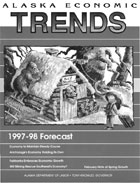
Alaska's economy will continue to grow slowly through 1998, extending a nine-year string of job gains into its second decade. The industries critical to job growth during this period are air cargo handling, services, hard rock mining, trade, and the visitor sector. On the down side, segments of Alaska's oil and gas industry, the manufacturing sector and to a lesser extent the public industries. In spite of the negative factors, positive influences on the economy will tip the balance toward job increases. However, the result is job growth that falls under the 1.0% mark in 1997 and rebounds to 1.0% in 1998.
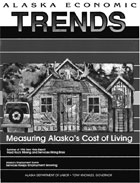
How expensive is it to live in Alaska? How much has Alaska's cost of living increased? These are two of the most frequently asked questions of the Alaska Department of Labor's Research and Analysis Section. In answerto thesequestions, this article provides some of the latest cost-of-living measurements available for Alaska and explains the uses and limitations of these data.
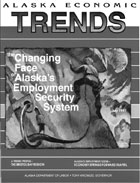
In the world of work today, the alliance between workers and employers is radically changing, and so is the business of linking job seekers to potential employers. Linking employers to workers and workers to jobs is the business of labor exchange. Labor exchange, beyond paying unemployment insurance benefits to the tens of thousands of Alaskan workers temporarily laid off each year, has been the role of the Alaska Department of Labor's (AKDOL) Employment Security Division for 60 years.
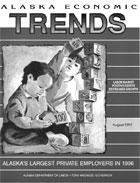
For the sixth straight year, Carr Gottstein Foods, a grocery chain, heads the list of the state's largest private sector employers.(See Tables 1 and 3.)ln 1996, Carr's provided an average of 3,299 jobsthe largest workforce ever recorded by one firm since the inception of this list in 1985. All other firms had at least a thousand fewer employees. The second and third largest employers were Providence AlaskaMedical Center and Fred Meyer respectively-a slightly different lineup from last year. ARC0 Alaska, which held the number two spot in 1995, slipped to fourth place as it continued to downsize.
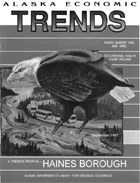
Haines Borough's nearly 2,400 square miles of rainforest, lakes, rivers and mountains lie at thenorthern end of Lynn Canal in the northern extremities of the Southeast Alaska Panhandle. Roughly double the area of the state of Rhode Island, Haines Borough shares part of its border with Canada's British Columbia.

The Matanuska-Susitna Borough is the third largest in Alaska, with 24,683 square miles; it is about the same size as West Virginia. Home to three incorporated cities and at least 13 other identified communities (See Table 1 .), the Mat- Su Borough is the third most populous area of the state. Even though the borough is large, and most of its landmass is remote, approximately 90 percent of its more than 52,000 residents live along the road system between Willow and Sutton. The few communities in the borough that are off the road system can be reached by boat, snow machine, off-road vehicle, bush plane or the Alaska Railroad
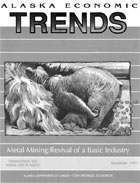
In the last two decades, oil has come to dominate Alaska's economy, but originally another sector of the mining industry fueled employment and population growth in the state. Metal mining, particularly the quest for gold, sparked the founding of many communities in Alaska's first 50 years as a territory and provided an economic base for these boomtowns. Settlements in the Southeast and Interior regions and the Kenai and Seward peninsulas sprang up during the early gold rushes. Metal mining activity decreased in the years following statehood due to low metal prices, high costs and lack of infrastructure. It recently has rebounded. Although it now represents only a small portion of the state's economy, metal mining has the potential for significant growth. This article examines the current structure and economic impacts of Alaska's metal mining industry.
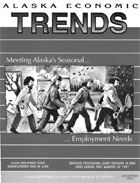
For many years, one of the most important tasks of the Alaska Department of Labor has been tracking levels of employment, labor force, and earnings. Every year, Alaska's economy experiences huge seasonal swings in these measures, the degrees of which are unrivaled by any other state. In 1996, for example, employment in the state's peak month exceeded that in the lowest month by nearly 35,000 jobs, or more than 14 percent. Seasonality in the Alaska economy exists for obvious reasons, and although the state's maturing economy has helped moderate the seasonal swings, nothing will stop them from recurring each year.
